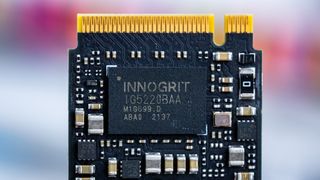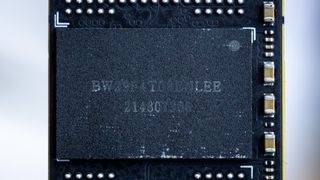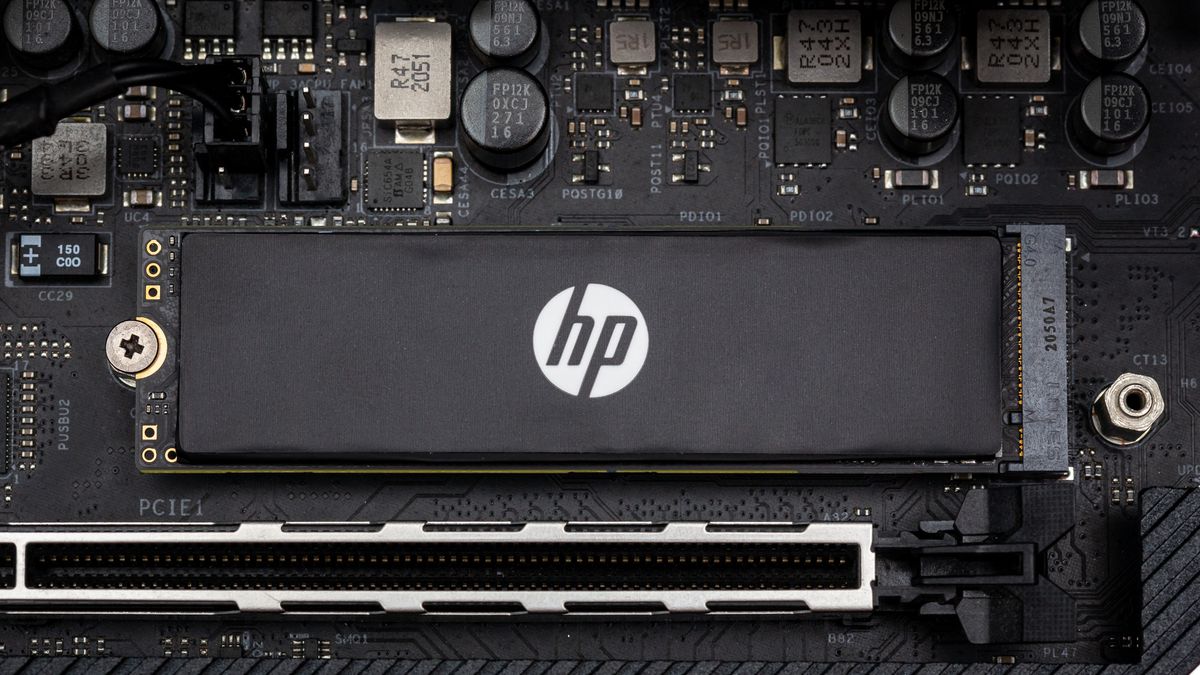Tom's Hardware Verdict
The 1TB HP FX900 is a mid-range PCIe 4.0 SSD that generally exceeds expectations and proves that “DRAM-less” is no longer a bad word. It’s plenty fast and affordable but isn't perfect.
Pros
- +
Reasonable Pricing
- +
Power-efficient
- +
Strong sustained writes
- +
Snappy performance in typical desktop OS
Cons
- -
WD’s SN770 rivals it despite having weaker flash
Why you can trust Tom's Hardware
The HP FX900 has snappy performance and a competitive price point that will certainly find its way to our list of best SSDs with an astonishing 828,000/663,000 peak read/write IOPS.
It may surprise people to learn that HP has made some decent SSDs. (Well, the HP SSDs are actually made by BiWin for HP, but you get the idea.) The first HP SSD, the HP EX920, released in 2018, was an early example of a competitive consumer drive that didn’t start with the name Samsung. Intel had tried previously with its 600p, which, while ambitious, was limited by Micron’s early 3D TLC flash and SMI’s immature SM2260 controller. The HP EX920 combined 64-layer Micron TLC with the SM2262 to offer excellent everyday performance. HP later brought out its bring out its EX950 to make use of a new SM2262EN controller revision. It still remains competitive with drives that were built on the Phison E12, now E12S, controller.
HP also made some less-successful SSDs like its EX900, an entry-level DRAM-less option that was not as reliable in practice. DRAM-less drives from that era — those based on SMI’s SM2263XT and Phison’s E13T — tended to be problematic. However, more recent DRAM-less drives have proven to be robust and even downright fast, like with WD’s SN770. Expectations are that the HP FX900, based on the DRAM-less InnoGrit IG5220 controller, will also shine, particularly as it uses very fast flash.
The FX900 also has a faster sibling in the FX900 Pro, a drive we will review at a future date. For now, we want to see how this drive measures up not only against the older designs it’s replacing but even newer, high-end drives. Is it really fair to call this “entry-level” or even “mid-grade” in any meaningful use of those terms?
Specifications
| Product | 256GB | 512GB | 1TB | 2TB |
|---|---|---|---|---|
| Pricing | N/A | $64.99 | $104.99 | N/A |
| Capacity (User / Raw) | 256GB / 256GB | 512GB / 512GB | 1024GB / 1024GB | 2048GB / 2048GB |
| Form Factor | M.2 2280 | M.2 2280 | M.2 2280 | M.2 2280 |
| Interface / Protocol | PCIe 4.0 x4 | PCIe 4.0 x4 | PCIe 4.0 x4 | PCIe 4.0 x4 |
| Controller | InnoGrit IG5220 | InnoGrit IG5220 | InnoGrit IG5220 | InnoGrit IG5220 |
| DRAM | No (HMB) | No (HMB) | No (HMB) | No (HMB) |
| Flash Memory | 176-Layer Micron TLC (B47R) | 176-Layer Micron TLC (B47R) | 176-Layer Micron TLC (B47R) | 176-Layer Micron TLC (B47R) |
| Sequential Read | 4,600 MBps | 4,900 MBps | 5,000 MBps | 5,000 MBps |
| Sequential Write | 1,700 MBps | 3,300 MBps | 4,800 MBps | 4,800 MBps |
| Random Read | 281,000 IOPS | 545,000 IOPS | 828,000 IOPS | 820,000 IOPS |
| Random Write | 325,000 IOPS | 501,000 IOPS | 663,000 IOPS | 645,000 IOPS |
| Security | N/A | N/A | N/A | N/A |
| Endurance (TBW) | 100 TBW | 200 TBW | 400 TBW | 800 TBW |
| Part Number | 57S54AA | 57S54AA | 57S54AA | 57S54AA |
| Warranty | 5-Year | 5-Year | 5-Year | 5-Year |
The HP FX900, manufactured with the assistance of BiWin, comes in 256GB, 512GB, 1TB, and 2TB capacities. Unfortunately, we could only find the middle two SKUs available for purchase at the time of review. These are priced competitively but, as always, consider sales before making a purchase.
Performance tops out at 5/4.8 GBps for sequential read and writes, with IOPS hitting an astonishing 828,000/663,000 peak for read and write, both respectively. Astonishing because this drive is based on a quad-channel, DRAM-less controller pushing numbers that would put even the best PCIe 3.0 NVMe drives to shame. We suspect there’s a bit of fudging here as these numbers exceed what InnoGrit lists for the IG5220, especially as we similar high-balling with the FX900 Pro and IG5236 - although IOPS this extreme are not realistically achievable, anyway.
The specifications indicate this is an entry-level to mid-range NVMe SSD, DRAM-less but able to benefit from PCIe 4.0 bandwidth to a limited degree. There are some similarities to drives based on the Phison E16 controller, which has DRAM, but this is clearly newer technology. As such, it’s positioned more to compete with WD’s excellent SN770.
HP offers a 5-year warranty with 400 TBW per TB of capacity. This is less than typical for a standard NVMe drive but more than adequate for most users.
Software and Accessories
The HP SSDs have always been no-frills, although they do come with an M.2 screw. While it is not difficult to get M.2 screws and they should come with most motherboards and adapters, users nevertheless seem to always ask if a drive comes with the screw. It’s a bit like asking if a SATA SSD comes with a SATA cable — the answer is that most don’t. However, this one does come with the screw.
A Closer Look




We see the controller, two NAND packages on the top side, and no DRAM — a minimalist experience, to be sure. The back label contains basic information about the drive. The top label serves a purpose, though, as hinted at in the pictures, it’s actually a graphene thermal pad that assists with the dissipation of excess heat.

The InnoGrit IG5220, also known as the RainierQX, is a 4-channel, DRAM-less PCIe 4.0 controller. It does have a DRAM-equipped sibling in the IG5221 RainierQ, but this has not commonly been seen in the wild. The IG5220 is very powerful and capable for what it is and should not be underestimated. Could it help herald a new era of super-capable DRAM-less drives? Some people even wonder if this much bandwidth is even necessary, but it is impressive for a 4-channel controller.

The flash is difficult to read but seems to be labeled BW29F4T08ENLEE. This would indicate BiWin-binned flash from Micron (MT29-equivalent) in 4Tb or 512GB packages, with 8-bit TLC flash of the 176-layer generation. This flash has been used to good effect on many drives utilizing the Phison E18 controller. Some commenters are eager to say that NAND flash has not improved much where it matters - Q1T1 random performance - but that overlooks just how far you can reach with this flash on the IG5220. Additionally, DirectStorage should help users take better advantage of this potential.
MORE: Best SSDs
MORE: How We Test HDDs And SSDs
MORE: All SSD Content

Shane Downing is a Freelance Reviewer for Tom’s Hardware US, covering consumer storage hardware.
-
helper800 Reply
I got a 2tb one in my current PC and it only cost me 170 USD. It is, and was a great drive.tennis2 said:Ah the good ol' days of the HP EX950. -
deesider Slight differences in performance just don't matter any more - they all basically work the same. It's just a matter of availability and priceReply
